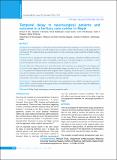Please use this identifier to cite or link to this item:
https://hdl.handle.net/20.500.14356/1079Full metadata record
| DC Field | Value | Language |
|---|---|---|
| dc.contributor.author | Sah, Hemant | - |
| dc.contributor.author | Shrestha, Dipendra | - |
| dc.contributor.author | Rajbhandari, Binod | - |
| dc.contributor.author | Sedain, Gopal | - |
| dc.contributor.author | Pradhanang, Amit | - |
| dc.contributor.author | Shilpakar, Sushil | - |
| dc.contributor.author | Sharma, Mohan | - |
| dc.date.accessioned | 2023-04-23T06:52:33Z | - |
| dc.date.available | 2023-04-23T06:52:33Z | - |
| dc.date.issued | 2021 | - |
| dc.identifier.citation | SahH., ShresthaD., RajbhandariB., SedainG., PradhanangA., ShilpakarS., & SharmaM. (2021). Temporal Delay in Neurosurgical Patients and Outcome in a Tertiary Care Center in Nepal. Journal of Nepal Health Research Council, 19(1), 170-174. https://doi.org/10.33314/jnhrc.v19i1.3429 | en_US |
| dc.identifier.issn | Print ISSN: 1727-5482; Online ISSN: 1999-6217 | - |
| dc.identifier.uri | http://103.69.126.140:8080/handle/20.500.14356/1079 | - |
| dc.description | Original Article | en_US |
| dc.description.abstract | Abstract Background: Neurosurgery is a field where time from the incident to get treatment is very crucial. In low-income countries, the referral system is not well developed. In our country, a proper referral system is in the initial phase of development. We conducted a study assessing the number of visits a neurosurgery patient made before finally reaching to our center. Methods: This is a prospective observational study involving seventy patients, conducted at Tribhuvan University Teaching Hospital, Kathmandu, Nepal. Demographic characteristics, neurological diagnosis, and numbers of other centers the patients visited and outcome at discharge and in one month was assessed. Results: Thirty-five (50%) patients were males. Thirty-three (47.1%) patients were admitted due to head injury and 13 (18.5%) were diagnosed with subarachnoid hemorrhage. Surgery was done in 32 (45.7%) patients. Fifty-three (75.7%) patients were transferred from other hospitals. Out of 53 patients, 30 (56.6%) and 17 (32%) had visited to one and two hospitals respectively. Unavailability of the neurosurgery facility was the main reason (77.4%) for the transfer. Overall mortality was 12.9%. The trend for mortality and length of hospital stay was higher in the group who visited other centers before coming to us than those who came directly. Conclusions: Visiting multiple hospitals where there is no neurosurgical service available is an important reason for delay. There is a need to develop neurosurgical facilities in the different parts of the country along with establishment of an effective referral mechanism. Keywords: Delay; Nepal; neurosurgery; outcome; prospective study | en_US |
| dc.language.iso | en | en_US |
| dc.publisher | Nepal Health Research Council | en_US |
| dc.relation.ispartofseries | Jan-March, 2021;3429 | - |
| dc.subject | Delay | en_US |
| dc.subject | Nepal | en_US |
| dc.subject | neurosurgery | en_US |
| dc.subject | outcome | en_US |
| dc.subject | prospective study | en_US |
| dc.title | Temporal Delay in Neurosurgical Patients and Outcome in a Tertiary Care Center in Nepal | en_US |
| dc.type | Journal Article | en_US |
| local.journal.category | Original Article | - |
| Appears in Collections: | Vol. 19 No. 1 (2021): Vol. 19 No. 1 Issue 50 Jan-Mar 2021 | |
Files in This Item:
| File | Description | Size | Format | |
|---|---|---|---|---|
| 3429-Manuscript-21571-1-10-20210425.pdf | Fultext Download | 219.67 kB | Adobe PDF |  View/Open |
Items in DSpace are protected by copyright, with all rights reserved, unless otherwise indicated.
